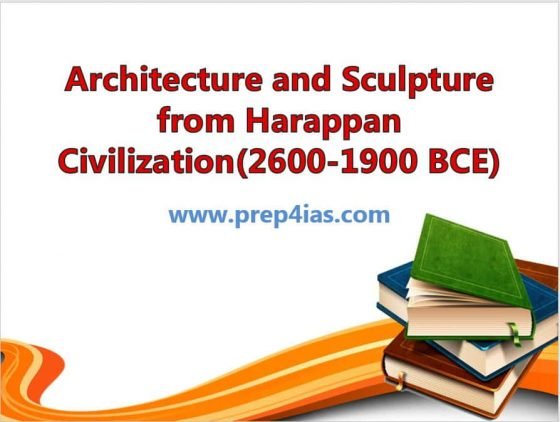In this article, we are going to look into the architecture and sculpture from Harappan Civilization, also known as Indus valley civilization from the mature Harappan phase between 2600 to 1900 BCE. As you might be aware, Harappan Civilization is divided into three phases - the Early Harappan Phase from 3300 to 2600 BCE, the Mature Harappan Phase from 2600 to 1900 BCE, and the Late Harappan Phase from 1900 to 1300 BCE. Here we are going to specifically focus on the development of architecture and sculpture during the Mature Harappan Phase from 2600 to 1900 BCE.

Architecture and Sculpture from Harappan civilization(2600-1900 BCE)
Also Read: Shimla Agreement 1972: Accord Signed After Bangladesh War,1971
Architecture
Most popular site from Harappan civilization are Mohenjodaro, Harappa, Banawali, Dholavira, Lothal etc. among which Mohenjodaro was one of the most popular and largest site in Harappan civilization. Town Planning in Mohenjodaro:-
- The architecture of Mohenjodaro depicts that there were two sections, upper town(also known as citadel) and lower town.
- Most of the buildings were either in square or rectangular shape.
- Whole town was properly fortified.
- Well planned drainage system was present both in upper and lower town.
- Each building followed the same pattern of architecture from inside. There was a center courtyard surrounded by multiple number of rooms whose doors opens directly to the courtyard. There were no windows in any rooms which depicts that privacy was the crucial for people.
- There was a great bath found only in citadel(upper town).
- Warehouses were made of woods in citadel whereas in lower town they were made of bricks.
Most of the site's architecture were same except few which followed different architecture than the rest. Eg. Dholavira architecture was such that it was divided into 3 section upper town, middle town and lower town.
Sculptures
Various sculptures has been recovered from the ancient Harappan civilization which includes Stone Statues, Metal Casting Statues, Terracotta Statues, Seals, Pottery, Beads and Ornaments. We will see them one by one.
1. Stone Statues
a) Priest king
- Most famous stone statue from this civilization is called priest king statue which was founded in Mohenjodaro.
- Raw material used to make this statue was soapstone(steatite).
- Fillet, Armlet and Necklace can be observed in the statue.
- Eyes were half closed which gives a sense of meditation mode.
- Upper body draped in a trefoil pattern shawl.
b) Male Torso
- This statue was found in Harappa site.
- Raw material used to make the statue was red sandstone.
- Depicts sophisticated modelling.
- Status was made from different pieces of stone which were joint together.
c) Dancing Male Torso
- This statue was found in Harappa site.
- Raw material used to make the statue was grey sandstone.
- Posture of the statue depicts that dance and music might had important place in their lives.
2. Metal Casting Statues
The lost-wax technique was used to make these kind of statues.
a) Dancing Girl Figurine
- This statue was found in Mohenjodaro.
- Raw material used to make the statue was bronze which is an alloy made of tin and copper.
- Bangles, Necklace and Armlet can be seen on the statue.
- Status is in standing position with a pose which depicts and showcase the sex, gender and other aspects of social identities.
b) Bronze Buffalo from Mohenjodaro
c) Bronze Bull from Kalibangan
d) Birds from Lothal
3. Terracota Statues
Terracota means burnt clay which turns into brownish-red color after burning. Unlike stone and bronze statues, the terracota representations of human form were crude.
a) Mother Goddess
- Statues were found in Mohenjodaro.
- Statues were hand made.
- Statues were not finely made which depicts these were made by normal people
- Statue were heavily found in many building and homes which depicts it's importance for peoples and hence being called as goddess.
b) Mask of horned deity from Harappa
c) Bearded horned deity from Mohenjodaro
4. Seals
- Thousands of seals have been founded from Harappa civilization. These seals are found from different Harappan sites.
- Seals are made up of steatite, agate, faience, chert, gold, terracota and ivory.
- Maximum found seals are made up of steatite.
- Seals were used for trading. It was also used as amulets by the people who owned them.
- Mostly seals have beautiful figures of animals drawn on it. Such as elephants, tigers, bulls goats etc.
- Seals are divided into various category based on the picture patterns drawn on them. Eg. Trident hand seals, Indus cylinder seals, Multi animal seals etc.
- Seals are in pictographic scripts whose language till date remains mysterious.
5. Pottery
- Plenty of pottery have been discovered which are in different shape and sizes. This depicts the different usage of potteries.
- Potteries are made up of good quality of clay. They are hand made as well as wheel made.
- Based on discovery, potteries are categorized as Plain pottery, Painted pottery and decorative pottery.
6. Beads and Ornaments
- Different kind of raw materials are used to make Ornaments. eg. gold, silver, bones , gemstones, baked clay, ivory, beads etc.
